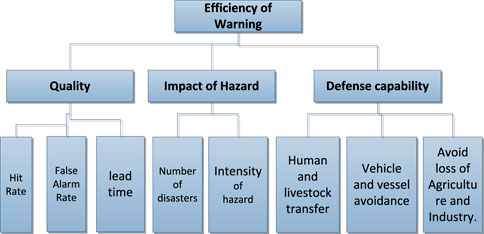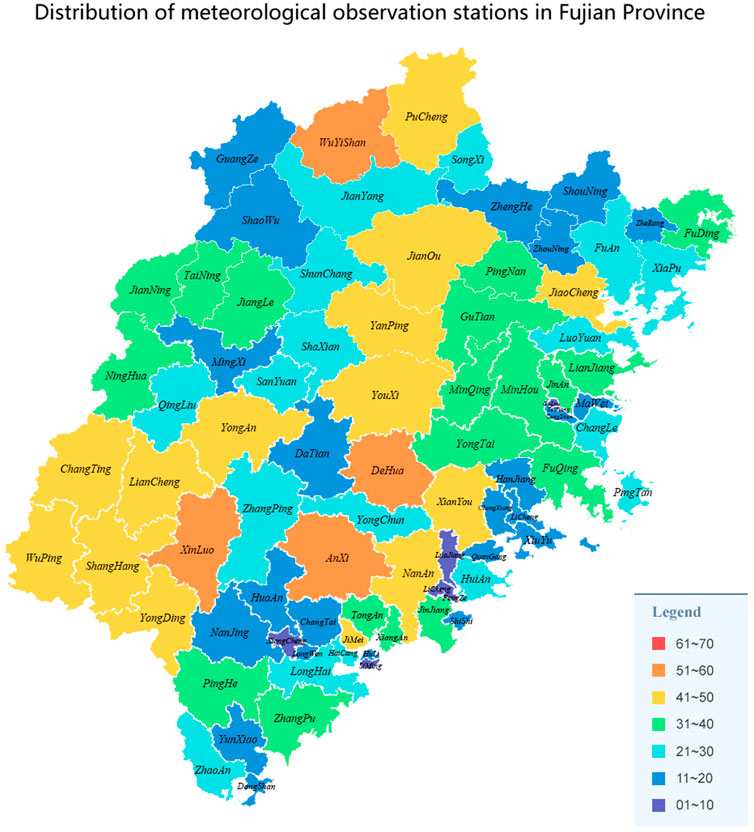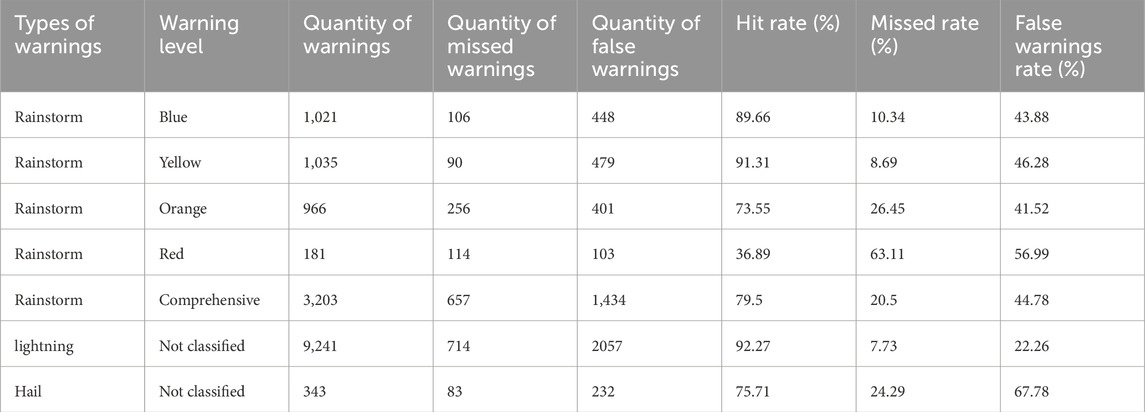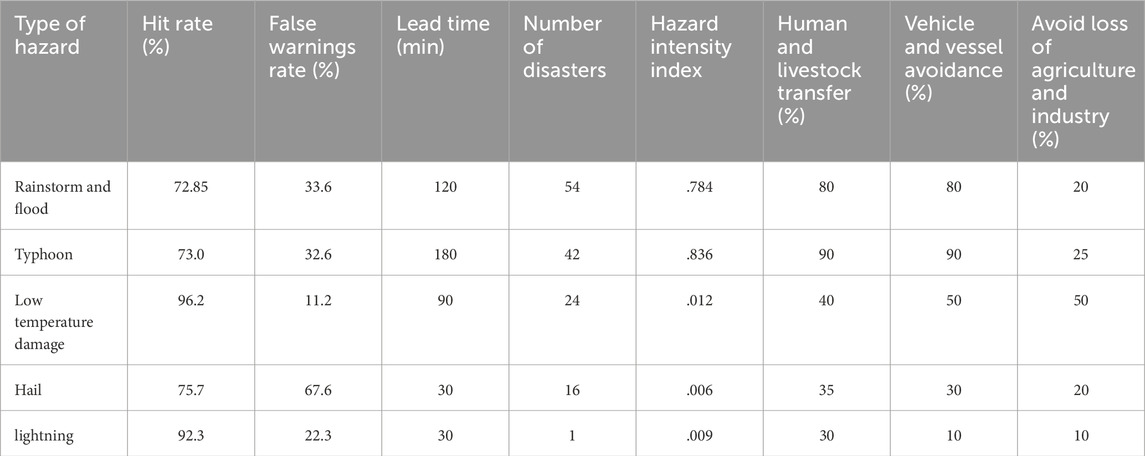- 1Public meteorological Service Center, Beijing, China
- 2Fujian Early Warning Center, Fuzhou, China
To refine the meteorological warning service for decision makers and enhance their role in disaster risk reduction, this paper puts forward the efficiency index for warning on disaster risk reduction by analyzing meteorological warnings. The influence factors of the index are investigated, and an index calculation model is established by using Grey relation analysis. The weights of the evaluation factors are determined by entropy weight method to quantify the efficiency of warning. Additionally, the reminder strength of different warning delivery methods to decision makers is studied, and a refined delivery strategy tree for warnings to decision makers is established based on the efficiency index and reminder strength of delivery means. The proposed strategy has been applied to the warning service system in Fujian Province. Results show that its implementation has improved the efficiency of warning dissemination and reduced delivery warning costs.
1 Introduction
In recent years, meteorological warning technology and its effectiveness in disaster risk reduction have been constantly improved in China (Zeng et al., 2015; Zheng et al., 2015), and the social benefits of early warning service have become increasingly evident (Meng et al., 2016). Nevertheless, the excessive dissemination of warnings has become a difficult problem in the research field of early warning service (Wang and Zhang, 2011; Huang et al., 2017). The author proposed a communication strategy (Cao et al., 2021a) for warnings spread to the public and applied it in business systems (Cao et al., 2021b), but the precise delivery of warnings to decision makers (emergence managers) (Zhou et al., 2017; Chen et al., 2021) remains unresolved.
Decision makers need to conduct risk perception, maintain situational awareness and make judgment on whether to increase the number of patrols and organize the evacuation of the masses in response to disasters (Lim et al., 2016; Piciullo et al., 2017). At present, most of decision makers in China independently subscribe to the warning types in the early warning service system, lacking an objective basis to a certain extent. As a result, it will inevitably lead to excessive or insufficient selection of warning types. Experts in warning service have proposed some delivery mechanisms for decision makers (Xia et al., 2019; Yang et al., 2019). These methods have been applied in several provinces of China. However, its effectiveness is limited due to the lack of specific delivery strategies. Providing appropriate delivery services for decision makers at different emergency decision-making levels for different types of warnings as well as providing accurate services, has become a new challenge for researchers in warning service.
To establish a strategy for warning delivery to decision makers, it is necessary to evaluate the effectiveness of warning on disaster risk reduction and the reminder strength of delivery means. To achieve this, the Efficiency Index for Warning (EIW) is defined in this paper. The result of the quality evaluation of warnings conducted in current meteorological business operations was applied (Huang et al., 2015; Lu et al., 2018). Meanwhile, the comprehensive disaster intensity of meteorological hazard (Cao et al., 2021a) and disaster defensive capability (Kong et al., 2018) were analyzed.
Fujian Province, located along the coast of China, is prone to meteorological disasters. As the meteorological industry in Fujian Province has issued a large number of warnings in recent years, which have played a good role in disaster risk reduction (Chen, 2020; Xie et al., 2023), the indicator selection and weight calculation of warnings in this province are presented here as an example.
2 Materials and methods
Grey relation analysis method can solve the problem of uncertainty in influencing factors between multiple indicators can be solved. At the same time, the requirements for sample size and regularity are not high, and the computational complexity is small, making it easy to apply. There will be no discrepancies between quantitative results and qualitative analysis results. EIW effected by multiple influencing factors and the sample size of the warnings is not very large. These features fit for Grey relation analysis method. Therefore we use the method to establish a multi-factor comprehensive evaluation model.
The entropy weight coefficient method, based on the concept and properties of entropy, quantifies and synthesizes the inherent information of various candidate results and the subjective information of decision makers’ empirical judgments in multi indicator decision evaluation. It establishes the size of multi indicator weights based on entropy, which can effectively compensate for the subjectivity of determining weights. In the algorithm of EIW, the entropy weight method was used to calculate the weight of performance indicators.
2.1 Definition of entropy
The concept of entropy originates from thermodynamics and is used to describe the irreversible phenomena of processes. In information theory, the entropy value reflects the amount of information provided by indicators in the system and quantifies the effective information provided by data (Lu and Wang, 2013). According to the information theory, the greater the probability of an event, the more orderly it will be. The higher the degree of order, the greater the information entropy, and the smaller the weight of the information. The entropy weight method has been widely used in analysis and research of multiple indicators to address the subjectivity of weights assignment (Su et al., 2007; Liang et al., 2017; Cheng, 2020).
2.2 Application of entropy weight method
For the system using multiple indicator analysis, there are m evaluation elements, each of which evaluates n indicators to form an evaluation matrix D:
Where D is the initial data matrix; dij is the value of the jth index of the ith element in the system.
Eq. 1 is standardized to get the standardized matrix S=
In Eq. 2 ej is the entropy value of the jth index; k is a constant related to the measured value of the system sample;
When the order degree of the system is 0, its entropy value is maximum, that is, e = 1. When the order degree of the system is 0,
When ln
where
When the information entropy is completely disorder, e = 1, and the utility value to the evaluation target is also 0. In this case, the utility value of an indicator depends on the difference
2.3 Determination of influence factors of the efficiency index for warning
After studying a large amount of relevant literature and consulting with business management departments and emergency decision makers, we followed the principles of systematization, accuracy, and feasibility of warning service. We comprehensively analyzed and determined the key factors that affect the effectiveness of warning on disaster risk reduction, including warning quality, hazard impact, and the feasibility of disaster risk reduction of hazard.
In meteorological business operation, the quality of warning is mainly evaluated and verified by hit rate, missed rate and false rate (Forecast and Network Department of China Meteorological Administration, 2014; Huang et al., 2015; Eric, 2017; Lu et al., 2018). The EIW on disaster risk reduction can more comprehensively reflect the role of warning. It not only describes the effectiveness of specific hazard warnings in a certain region, but also provides a comparative relationship among the warnings of different hazard.
The type of hazard in a certain area is one of the most important factors affecting the effectiveness of warning. The comprehensive disaster intensity index (CDII) evaluates the severity of disasters caused by a certain hazard in a region, and quantitatively describes the local losses. Our research team has completed the algorithm model design and application of the CDII. The index ranges from 0 to 1. The larger the index, the greater the loss caused by the hazard.
The number of disasters describes the frequency of disasters caused by a certain hazard in one region. The more disasters a hazard causes, the higher the efficiency of this hazard warning will be because the decision makers will pay more attention.
The efficiency of warnings is heavily dependent on the quality of warnings. The accuracy of warnings, i.e., hit rate, is the dominant factor of warning effectiveness. False warnings and missed warnings reduce the reliability of warnings directly, which can lead to reduced attention from decision makers.
The efficiency of warnings is also closely related to the capability to defend against disasters, which is the feasibility of reducing the exposure of the disaster-bearing bodies when the disaster occurs (Wang and Wang, 2004). It shall specifically include the feasibility ratio of adopting effective measures such as human and animal transfer, vehicle and vessel avoidance, industrial and agricultural protection for the duration of the lead time of the warning.
According to the above analysis, the specific model that we developed is shown in Figure 1.
3 Results
3.1 Model matrix construction and algorithm application
Fujian Province is located on the southeast coast of China, adjacent to the Pacific Ocean. It is affected by various factors such as the ocean and mountains, and is prone to meteorological disasters (Chen et al., 2018; Lin, 2023). According to the general survey data of meteorological disaster risk of the China Meteorological Administration (CMA), the distribution of typhoon, rainstorm and other disasters in Fujian Province is shown in Figure 2.
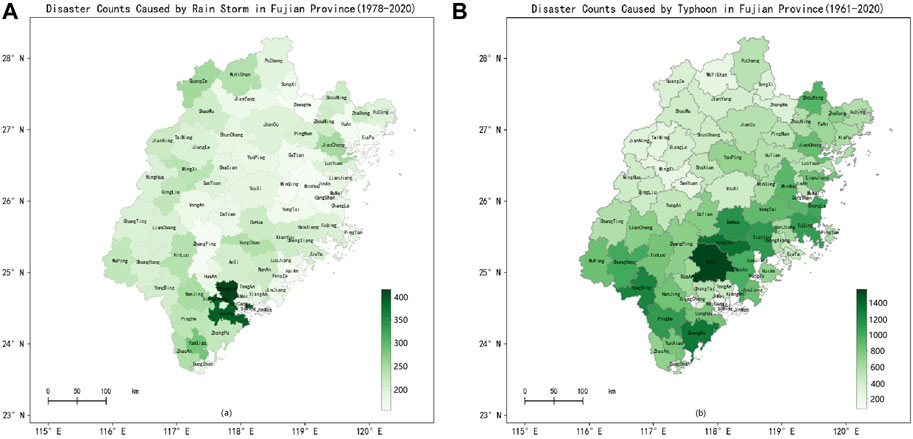
Figure 2. Distribution of meteorological disasters in Fujian Province (A) Disaster counts caused by rainstorm. (B) Disaster counts caused by Typhoon.
To provide better meteorological warning services, the provincial meteorological department has continuously strengthened the construction of meteorological observation stations. A complete observation network across the whole province is formed, as shown in Figure 3.
Due to the increasing importance Fujian Province has placed on the issuance of warning in recent years, the refinement level of warning issuance has continuously improved, resulting in a certain benefit (Chen, 2020). The hazard that causes major disasters in Fujian Province such as rainstorm and floods, typhoons, low temperatures and cold damage, hail, and lightning are selected as the research objects. Disaster data from 2016 to 2020 in the Direct Reporting System of Meteorological Disaster of CMA are obtained as research samples. The corresponding warning quality is based on the warnings issued by counties in Fujian Province, as shown in Table 1.
The TS (a kind of evaluation in forecast technique skill) score of typhoon warnings, including the hit rate, in Fujian is not reported. According to (LYU et al., 2021), the accuracy of typhoon warnings in Fujian is not lower than that of rainstorm warnings. With reference to the data of rainstorm warnings, the comprehensive evaluation results are obtained, as shown in Table 2. The disaster intensity index is calculated based on the method proposed by (Cao et al., 2021b).
Grey relation analysis method is used to establish the model matrix and calculate the efficiency of warning on disaster risk reduction. The processing steps are as follows.
(1) Establishing indicator matrix
(2) Normalizing the above matrix
(3) Using entropy weight method to obtain objective weight of evaluation matrix
(4) Calculating the EIW of each type of hazard
The results show that the typhoon warning has the highest EIW among the five types of warning studied, mainly because of the strong intensity of typhoon disasters, high warning accuracy, and long lead time. By contrast, lightning warning, whose EIW is only one-10th of that of typhoon warning, has the lowest EIW, which is reflected in the low disaster intensity, short lead time, and poor defense capability in a short period.
3.2 Effectiveness analysis and strategy configuration of warning delivery service means
The warning service for decision makers is a very important function in every warning center. Specifically, the warning is sent to decision makers by electronic information transmission means, and the results of information transmission are the reply of decision makers or the transmission system. The major delivery means include fax, email, WeChat group, short message service (SMS) and outbound call. Each means has reminder way to the recipient. The effectiveness of different delivery means is defined as reminder effectiveness. Analyzing the reminder effectiveness is conducive to matching the efficiency of warnings with the delivery means.
3.2.1 Effectiveness of warning reminder means
Reminder effectiveness evaluation mainly includes factors such as reminder strength of delivery means, delivery capacity, feedback duration, and delivery cost (Wang and Zhao, 2022). The reminder strength of the delivery means includes the strength of the reminder tone and the amount of such information received by the decision makers. For example, the amount of information received by the decision makers through WeChat group is far greater than that received by SMS at present, although they have similar reminder tone. Therefore, the strength of the reminder of WeChat group is lower than that SMS. Delivery capacity refers to the number of people that can be served in a unit of time by delivery means. Feedback duration refers to the time it takes decision makers to respond to the warning information after it has been sent. Delivery cost refers to the economic cost of maintenance delivery system and communication. For example, the multi-channel outbound call system requires maintenance service, and each call made through the system incurs a cost. The analysis of major effectiveness factors in Fujian Province is reported in Table 3.
To further analyze the role of each evaluation factor, each factor is qualitatively classified. The analysis results show that the effectiveness of warning delivery means (EoD) is positively correlated with reminder strength (W), transmission speed (V), and feedback duration (T), but negatively with economic cost (C). The relationship among them is given by Formula (Eq. 4):
Where the coefficient
Related items in Table 3 are treated qualitatively and hierarchically, and then calculated by Formula (Eq. 4) to get Table 4.
The results show that the effectiveness of fax and email is low and at the same level. However, the cost of fax is the highest, making it the most undesirable delivery means. The reminder effectiveness of WeChat group is at the middle level, and its economic cost is significantly lower than that of SMS and outbound calls respectively. The reminder effectiveness of SMS and outbound call is at the highest level. The outbound call is the most effective reminder means, but its economic cost is also the highest. Its call-respond feature gives it a unique advantage over other delivery means.
3.2.2 Multi-level reminder service strategy for decision makers
In China’s emergency management system, the principle of territorial management is adopted (Jia et al., 2011; Huang, 2012). Therefore, the target of warning service for decision makers are mainly grassroots managers in counties, towns, villages, and different industries. These decision makers belong to different positions in emergency management and are generally divided into three levels based on their responsibilities and authorities, namely, on-duty staff, business supervisor, and administrative chiefs (Sun et al., 2022). These three levels of positions can also be reduced according to the actual situation at each level. In response to this characteristic, a strategy for warning delivery to decision makers can be established by considering the EIW of warnings, the reminder effectiveness of delivery methods, and the position of decision makers as a whole.
According to the value of the EIW, warning types are divided into three levels, and delivery methods are also divided into three levels based on the strength of reminder effectiveness. Establish a delivery strategy for decision makers in a step-by-step correspondence manner. The third-level warnings are only sent to the decision makers in on-duty position using the third-level means; The second-level warnings shall be sent to the decision makers who are on-duty staff and business supervisors using both the third-level and second-level means. The first-level warnings should be sent to all decision makers through all means, shown as in Table 5.
According to the above strategy, in the Early Warning Service System, warnings and delivery means for decision makers are automatically configured, and each warning delivery service can form a task order. The delivery task can be completed by using the corresponding information transmission methods.
Through the above analysis, the multi-level warning delivery service strategy tree is established, as shown in Figure 4.
According to the warning types, decision makers and delivery means, the following three-level service strategy matrix of county, town and village warnings is obtained: on-duty, business supervisor, and administrative chief.
If decision makers have multiple options for the delivery means of a certain type of warning, the delivery can be done in descending order of the economic cost of the delivery means. Once a delivery means has received a response from the decision maker, no other delivery means will be used. This not only reduces costs and improves the delivery efficiency, but also avoids duplicated delivery.
4 Conclusion and discussions
This paper proposes the concept of efficiency of warning on disaster risk reduction through an in-depth analysis of meteorological warnings, and provides a calculation method for the efficiency index for warning. It offers new approach to address the problem of digital evaluation of the role of warnings, thus providing a basis for specialized service strategies for decision makers. The paper also analyzes the impact of various factors such as the reminder strength and maintenance cost of delivery methods on decision makers, forming a service strategy tree for delivering different warnings to decision makers. It creates a unique strategy for warning service, addressing the issue that the existing warning service are too rough, which leads to a significant reduction in service effectiveness. This universal method can be applied and practiced in practical business in various regions.
The proposal of this method provides a new approach for refining warning services by establishing the association between warnings and the service population. It also provides a reference for future research, such as warning services for different age, gender groups, and industries.
The warnings have different threat severity levels. In this paper, when analyzing the efficiency of the warning, it is insufficient to analyze only the threat severity level attribute. The main reason is that the threat severity level regulations of some warnings are unclear. For example, the threat severity level of lightning warnings is determined only by the approaching time, while the threat severity level of rainstorm is determined by the precipitation. These are completely two unrelated dimensions. In the future, different threat severity levels of warnings for a hazard can be refined, and strategies can be made more precise.
Through the application of this strategy, the original reminder method was refined, which greatly reducing the frequency of reminders. Taking Fujian as an example, the number of reminders of lightning warnings was reduced to one-third of the original number, and the number of reminders of rainstorm warnings was reduced to one-fourth of the original number.
The application of these strategies can effectively alleviate the problem of excessive warning reminders to decision makers in current practice, stop or reduce unnecessary reminders, enable decision makers to focus more on high-impact warnings, and improve their work efficiency.
The EIW of lightning warning reflects that the impact of this type of hazard is very low. This is due to the increase in daily preventive measures in reducing disasters, as well as the lack of temporary response mechanisms against disasters when they occur. The dissemination strategy of such warnings should also distinguish between sensitive industries. More in-depth analysis of the correlation between hazard and the industries can be carried out to further refine the services.
To better enhance the role of meteorological warnings, efficiency and authority of the warnings should be emphasized while improving the timeliness, accuracy, and coverage of the warning. Problems in the issuance and dissemination of the warning with low EIW need to be addressed in future research.
Data availability statement
The original contributions presented in the study are included in the article/Supplementary Material, further inquiries can be directed to the corresponding author.
Author contributions
ZC: Conceptualization, Methodology, Writing–original draft, Writing–review and editing. JW: Writing–original draft. YL: Writing–original draft, Writing–review and editing. JZ: Writing–original draft. YS: Writing–original draft. BZ: Writing–original draft.
Funding
The author(s) declare that financial support was received for the research, authorship, and/or publication of this article. 1) Regular Science and Technology Assistance Projects of the Ministry of Science and Technology (KY202204004), 2) China Meteorological Administration Public Meteorological Service Center Innovation Fund Project (M2023002), 3) China Meteorological Administration Youth Innovation team plan (CMA2023QN02), 4) Climate Change Special Project of China Meteorological Administration (QBZ202410).
Conflict of interest
The authors declare that the research was conducted in the absence of any commercial or financial relationships that could be construed as a potential conflict of interest.
Publisher’s note
All claims expressed in this article are solely those of the authors and do not necessarily represent those of their affiliated organizations, or those of the publisher, the editors and the reviewers. Any product that may be evaluated in this article, or claim that may be made by its manufacturer, is not guaranteed or endorsed by the publisher.
References
Cao, Z., He, S., Sun, C., et al. (2021b). Design and implementation of new-generation cloud service platform for national emergency earlywarning. Sci. Technol. Eng. 21 (4), 1483–1488.
Cao, Z., Zhu, X., Lan, H., et al. (2021a). Research on automatic adaptation strategy of early warning information and dissemination means of natural disasters-taking hubei for example. J. Catastrophology 36 (3), 180–183. doi:10.3969/j.issn.1000-811X.2021.03.031
Chen, A. Y., Zhu, H. R., and Su, G. F. (2021). Emergency warning information repost behavior of Weibo users. J. Tsinghua Univ. Sci. Technol. 61 (6), 527–535. doi:10.16511/j.cnki.qhdxxb.2020.26.045
Chen, J., Huang, C., Sun, C., et al. (2018). Disaster-causing hazard division and evaluation of meteorological disasters for tea in Fujian Province. J. 0F Nat. DISASTERS 27 (1), 198–207. doi:10.13577/j.jnd.2018.0123
Chen, Q. (2020). Design and implementation of integrated management system of meteorological disasters warning signals for Fujian province. Meteorological Hydrological Mar. Instrum. (2), 63–66. doi:10.3969/j.issn.1006-009X.2020.02.015
Cheng, S. (2020). The KPI design method of performance assessment of hydraulic engineering construction enterprise based on entropy method. J. Shandong Univ. Eng. Sci. 50 (4), 80–84. doi:10.6040/j.issn.1672-3961.0.2019.785
Eric, G. (2017). A new characterization within the spatial verification framework for false alarms, misses, and overall patterns. WEATHER Forecast. 32, 187–198. doi:10.1175/waf-d-16-0134.1
Forecast and Network Department of China Meteorological Administration (2014). Quality verification measures for meteorological hazard warning (trial). Public doc. FCD CMA. [2014] No. 113.
Huang, G. L., Zhao, Y., Ma, J. H., et al. (2015). Analysis of meteorological disaster warning signal distribution characteristics and warning in guangxi. Meteorological Sci. Technol. 43 (2), 343–348. doi:10.19517/j.1671-6345.2015.02.030
Huang, X. (2012). Reflection on “high level intervention” in response to emergencies. J. Beijing Inst. Adm. (4), 46–49.
Huang, Y. X., Wang, S. X., Luo, J. H., et al. (2017). Influence of Authority of Information on Negative e WOM-Mediated by Social Relationship. J. Intell. 36 (11), 141–146. doi:10.3969/j.issn.1002-1965.2017.11.022
Jia, H. J., Liu, S., Jiang, C., et al. (2011). Investigation of emergency system at grassroots level. J. Saf. Sci. Technol. Vol. 7 (6), 38–42. doi:10.3969/j.issn.1673-193X.2011.06.008
Liang, G. Y., Li, Q., and Peng, X. Y. (2017). UGS design proposal optimization based on entropy weight-osculating value method. Oil Gas Storage Transp. 36 (7), 811–815. doi:10.6047/j.issn.1000-8241.2017.07.011
Lim, M. B. B., Lim, H. R., Piantanakulchai, M., and Uy, F. A. (2016). A household-level flood evacuation decision model in Quezon City, Philippines. Nat. Hazards 80, 1539–1561. doi:10.1007/s11069-015-2038-6
Lin, X. (2023). Analysis and prevention suggestions of the characteristics of marine meteorological disasters in Fujian Province from 2011 to 2020. J. Fish. Res. 45 (1), 80–87. doi:10.14012/j.cnki.fjsc.2023.01.011
Lu, J. C., and Wang, W. (2013). Distribution network assessment model based on entropy weight osculating value method. East China Electr. Power 41 (5), 1047–1050.
Lu, X. Y., Li, J. Y., Liang, W. L., et al. (2018). Quality assessment of guangxi meteorological disaster warning signal in recent years. J. Meteorological Res. Appl. 39 (4), 80–82. doi:10.3969/j.issn.1673-8411.2018.04.021
Lyu, M., Huixia, ZHAO, Zhang, X., et al. (2021). Preliminary study on benefit evaluation of disaster reduction of typhoon based on integrated disaster risk governance model. J. Catastrophology 36 (1), 157–163. doi:10.3969/j.issn.1000-811X.2021.01.030
Meng, R., Zheng, W. W., Hu, J. b., et al. (2016). Evaluation method of geological hazard meteorological risk early warning service benefit in hanzhong city. J. Anhui Agric. Sci. 44 (36), 210–212. doi:10.13989/j.cnki.0517-6611.2016.36.070
Piciullo, L., Mads-Peter, D., Devoli, G., Colleuille, H., and Calvello, M. (2017). Adapting the EDuMaP method to test the performance of the Norwegian early warning system for weather-induced landslides. Nat. Hazards Earth Syst. Sci. 17, 817–831. doi:10.5194/nhess-17-817-2017
Su, X., Xie, Y., Yuan, Z. M., et al. (2007). Optimization Of Long-Distance Natural Gas Pipeline Design Proposal Based On En Tropy-Weight Coefficient Method. Nat. Gas. Ind. 27 (4), 112–114. doi:10.3321/j.issn:1000-0976.2007.04.036
Wang, H., and Zhang, J. (2011). On the authoritativeness of releasing government information by mobile media. J. Beijing Univ. Posts Telecommun. Soc. Sci. Ed. 13 (1), 1–6. doi:10.3969/j.issn.1008-7729.2011.01.001
Wang, H. N., and Wang, J. (2004). Defensibility of geological disasters-Taking the collapse and slide flow disaster of the ash and slag reservoir of Zhengzhou Aluminum Plant for example. Henan Land & Resour. 2, 40–41. doi:10.3969/j.issn.1674-053X.2004.02.024
Wang, J. L., and Zhao, Y. (2022). Study on the matching scheme between early warning information dissemination demands and communication network dissemination channels. Telecommun. Sci. 5, 104–112. doi:10.11959/j.issn.1000−0801.2022101
Xia, Z. L., Li, L., Chen, Q. Q., et al. (2019). Analysis on meteorological service mechanism of “Three Calls” in heavy rainfall in Yuqing county. Mid-low Latit. Mt. Meteorol. 43 (1), 77–80. doi:10.3969/j.issn.1002-1965.2017.11.022
Xie, P., Lin, H., and Wang, S. (2023). Analysis on the characteristics of fujian meteorological disaster warning signals. J. Agric. Catastrophology 13 (1), 188–190. doi:10.3969/j.issn.2095-3305.2023.01.062
Yang, P. H., Liang, H. F., Zhang, W. Y., et al. (2019). Study on the threshold of “three call response” in libo county and optimization of the process of external calls. Mid-low Latit. Mt. Meteorol. 43 (4), 74–78. doi:10.3969/j.issn.1003-6598.2019.04.013
Zeng, J. Q., Zhu, B., Wang, Y. B., et al. (2015). The application of initiative lightning protection technology based on lightning nowcasting and warning. J. Appl. Meteorological Sci. 26 (5), 610–617. doi:10.11898/1001-7313.20150510
Zheng, Y. G., Zhou, K. H., Sheng, J., et al. (2015). Advances in techniques of monitoring, forecasting and warning of severe convective weather. J. Appl. Meteorological Sci. 26 (6), 641–657. doi:10.11898/1001-7313.20150601
Keywords: warning issuance, efficiency index for warning, entropy weight method, warning delivery strategy, reminder strength of delivery means
Citation: Cao Z, Wang J, Liu Y, Zhao J, Song Y and Zhao B (2024) Multidimensional evaluation and service strategy analysis of hazard warning and risk reduction. Front. Earth Sci. 12:1362906. doi: 10.3389/feart.2024.1362906
Received: 29 December 2023; Accepted: 28 June 2024;
Published: 02 August 2024.
Edited by:
Guojie Wang, Nanjing University of Information Science and Technology, ChinaReviewed by:
Chao Gao, Ningbo University, ChinaSeyed Mohammad Sobhani, Agricultural Sciences and Natural Resources University of Khuzestan, Iran
Copyright © 2024 Cao, Wang, Liu, Zhao, Song and Zhao. This is an open-access article distributed under the terms of the Creative Commons Attribution License (CC BY). The use, distribution or reproduction in other forums is permitted, provided the original author(s) and the copyright owner(s) are credited and that the original publication in this journal is cited, in accordance with accepted academic practice. No use, distribution or reproduction is permitted which does not comply with these terms.
*Correspondence: Yingjie Liu, bGl1eWluZ2ppZUBjbWEuZ292LmNu
†Present address: Zhiyu Cao, National Early Warning Center, Beijing, China Jiahe Wang, National Early Warning Center, Beijing, China Yingjie Liu, National Early Warning Center, Beijing, China Jingjing Zhao, National Early Warning Center, Beijing, China Yingying Song, National Early Warning Center, Beijing, China
 Zhiyu Cao
Zhiyu Cao Jiahe Wang1†
Jiahe Wang1† Yingjie Liu
Yingjie Liu Yingying Song
Yingying Song